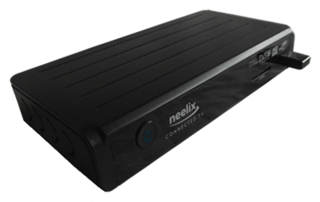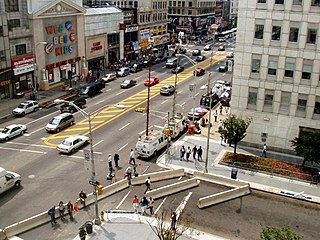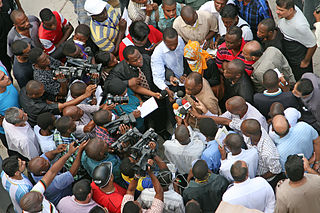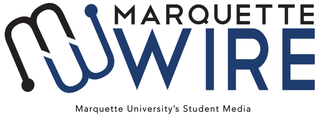
A set-top box (STB), also colloquially known as a cable box and historically television decoder, is an information appliance device that generally contains a TV-tuner input and displays output to a television set and an external source of signal, turning the source signal into content in a form that can then be displayed on the television screen or other display device. They are used in cable television, satellite television, and over-the-air television systems as well as other uses.

Broadcasting is the distribution of audio or video content to a dispersed audience via any electronic mass communications medium, but typically one using the electromagnetic spectrum, in a one-to-many model. Broadcasting began with AM radio, which came into popular use around 1920 with the spread of vacuum tube radio transmitters and receivers. Before this, all forms of electronic communication were one-to-one, with the message intended for a single recipient. The term broadcasting evolved from its use as the agricultural method of sowing seeds in a field by casting them broadly about. It was later adopted for describing the widespread distribution of information by printed materials or by telegraph. Examples applying it to "one-to-many" radio transmissions of an individual station to multiple listeners appeared as early as 1898.

The news media or news industry are forms of mass media that focus on delivering news to the general public or a target public. These include print media, broadcast news, and the Internet.
A television director is in charge of the activities involved in making a television program or section of a program. They are generally responsible for decisions about the editorial content and creative style of a program, and ensuring the producer's vision is delivered. Their duties may include originating program ideas, finding contributors, writing scripts, planning 'shoots', ensuring safety, leading the crew on location, directing contributors and presenters, and working with an editor to assemble the final product. The work of a television director can vary widely depending on the nature of the program, the practices of the production company, whether the program content is factual or drama, and whether it is live or recorded.

Bell Satellite TV is the division of BCE Inc. that provides satellite television service across Canada. It launched on September 10, 1997. As of April 2017, Bell Satellite TV provides over 700 channels to over 1 million subscribers. Its major competitors include satellite service Shaw Direct, as well as various cable and communications companies across Canada.

In journalism, electronic news-gathering (ENG) is when reporters and editors make use of electronic video and audio technologies in order to gather and present news. ENG can involve anything from a single reporter with a single professional video camera, to an entire television crew taking a truck on location. This term was coined during the rise of videotape technology in the 1970s. This term was commonly used in the television news in the 1980s and '90s, but is used less frequently now, as the technology has become commonplace. Sometimes the term videography is now used instead for news gathering on a smaller scale, often with hand-held equipment.

Electronic field production (EFP) is a television industry term referring to a video production which takes place in the field, outside of a formal television studio, in a practical location or special venue. Zettl defines EFP as using "both ENG and studio techniques. From ENG it borrows its mobility and flexibility; from the studio it borrows its production care and quality control. EFP takes place on location and has to adapt to the location conditions... Good lighting and audio are always difficult to achieve in EFP, regardless of whether you are outdoors or indoors. Compared to ENG, in which you simply respond to a situation, EFP needs careful planning."
News broadcasting is the medium of broadcasting of various news events and other information via television, radio, or internet in the field of broadcast journalism. The content is usually either produced locally in a radio studio or television studio newsroom, or by a broadcast network. It may include material such as sports coverage, weather forecasts, traffic reports, political commentary, expert opinions, editorial content, and other material that the broadcaster feels is relevant to their audience. An individual news program is typically reported in a series of individual stories that are presented by one or more anchors. A frequent inclusion are live or recorded interviews by field reporters.
Associated Press Television News, also referred to as AP Video and often abbreviated AP Television News or APTN, is a global video news agency operated by the Associated Press.

Broadcast journalism is the field of news and journals which are broadcast by electronic methods instead of the older methods, such as printed newspapers and posters. It works on radio, television and the World Wide Web. Such media disperse pictures, visual text and sounds.
Television crew positions are derived from those of film crew, but with several differences.
A television station is a set of equipment managed by a business, organisation or other entity, such as an amateur television (ATV) operator, that transmits video content and audio content via radio waves directly from a transmitter on the earth's surface to any number of tuned receivers simultaneously.
TVU Networks Corporation is a privately held technology company. Its headquarter is located in Mountain View California. It has major offices in Shanghai, China and Barcelona, Spain. They specialize in the development and sale of IP and cloud based products and services. The company was founded in 2005 by Paul Shen.

A satellite truck is a mobile communications satellite earth station, typically mounted on a truck chassis as a platform. Employed in remote television broadcasts, satellite trucks transmit video signals back to studios or production facilities for editing and broadcast. Satellite trucks usually travel with a production truck, which contains video cameras, sound equipment and a crew. A satellite truck has a large satellite dish antenna which is pointed at a communications satellite, which then relays the signal back down to the studio. Satellite communication allows transmission from any location that the production truck can reach, provided a line of sight to the desired satellite is available.

A news bureau is an office for gathering or distributing news. Similar terms are used for specialized bureaus, often to indicate a geographic location or scope of coverage: a ‘Tokyo bureau’ refers to a given news operation's office in Tokyo; 'foreign bureau' is a generic term for a news office set up in a country other than the primary operations center; a ‘Washington bureau’ is an office, typically located in Washington, D.C., that covers news related to national politics in the United States. The person in charge of a news bureau is often called the bureau chief.

Marquette Wire is the official outlet of Marquette University's student media, supported by the university's Diederich College of Communication, which allows students to gain real-world experience in producing mainstream media. Students studying journalism, digital media and other related fields can gain experience through writing, editing, producing and publishing content relating to Marquette and the surrounding Milwaukee community.
In terrestrial radio and television broadcasting, centralcasting refers to the use of systems automation by which customised signals for broadcast by multiple individual stations may be created at one central facility.

A television production truck or OB van is a small mobile production control room to allow filming of events and video production at locations outside a regular television studio. They are used for remote broadcasts, outside broadcasting (OB), and electronic field production (EFP). Some require a crew of as many as 30 people, with additional trucks for additional equipment as well as a satellite truck, which transmits video back to the studio by sending it up through a communications satellite using a satellite dish, which then transmits it back down to the studio. Alternatively, some production trucks include a satellite transmitter and satellite dish for this purpose in a single truck body to save space, time and cost.
Interruptible foldback (IFB), also known as interrupted foldback, interruptible feedback, or interrupt for broadcast, is a monitoring and cueing system used in television, filmmaking, video production, and radio broadcast for one-way communication from the director or assistant director to on-air talent or a remote location. The names are backronyms for the Telex IFB-XXX model line. Less common names for the system include program cue interrupt (PCI) and switched talkback. IFB is often facilitated using an earpiece that on-air persons wear to get cues, feedback or direction from their control rooms. The earpiece itself may also be referred to as an IFB. Sometimes IFB is accomplished by the director talking to off-camera personnel who visually cue the on-camera talent.
UPI Newstime was a cable television network founded by United Press International in 1978, and premiering July 3 of that year. UPI Newstime was the second 24-hour all-news television network in the US for cable TV, following AP Newscable for 13 years and predating CNN by 2 years. UPI Newstime was unique in how it distributed its programming to local cable TV (CATV) headends via satellite, using a form of slow-scan television, or SSTV technology. Using SSTV reduced satellite transmission costs for UPI and was suitable at the time for the programming produced by UPI for the channel, which mainly relied on still slides and wirephotos acquired by UPI's own newsgathering operations.
SatelliteNewsgathering, Second edition. Jonathan-Higgins. Focal Press. 2008. p239
Balancing Business Pressure and Journalism Values. Bob Steele.










